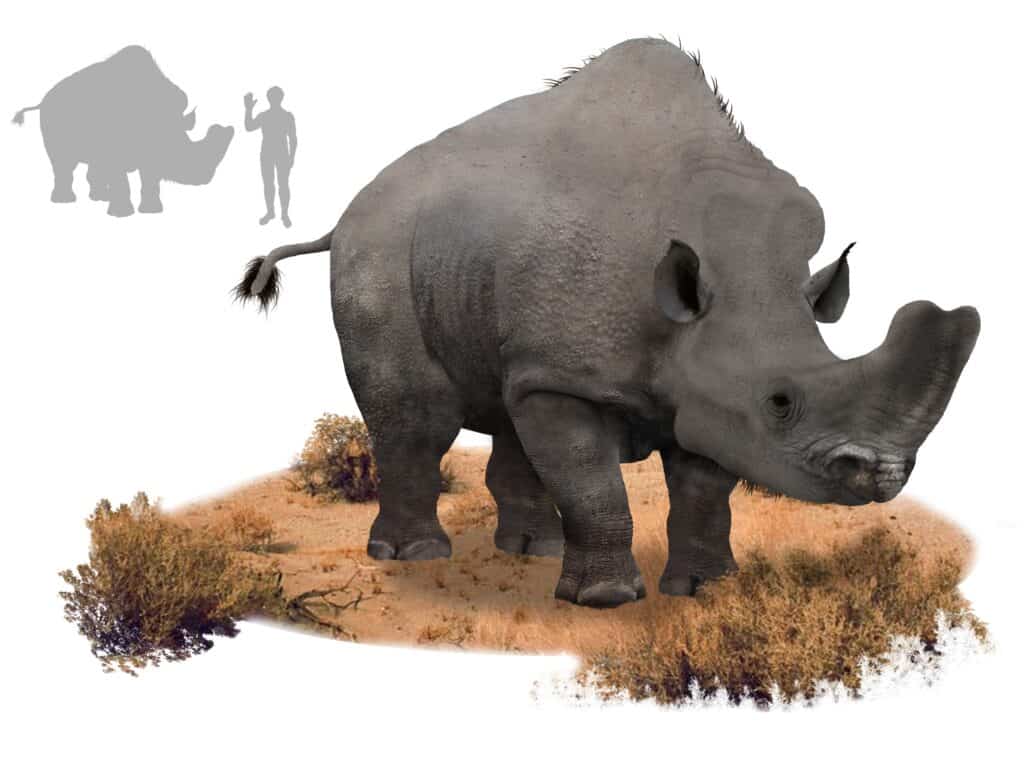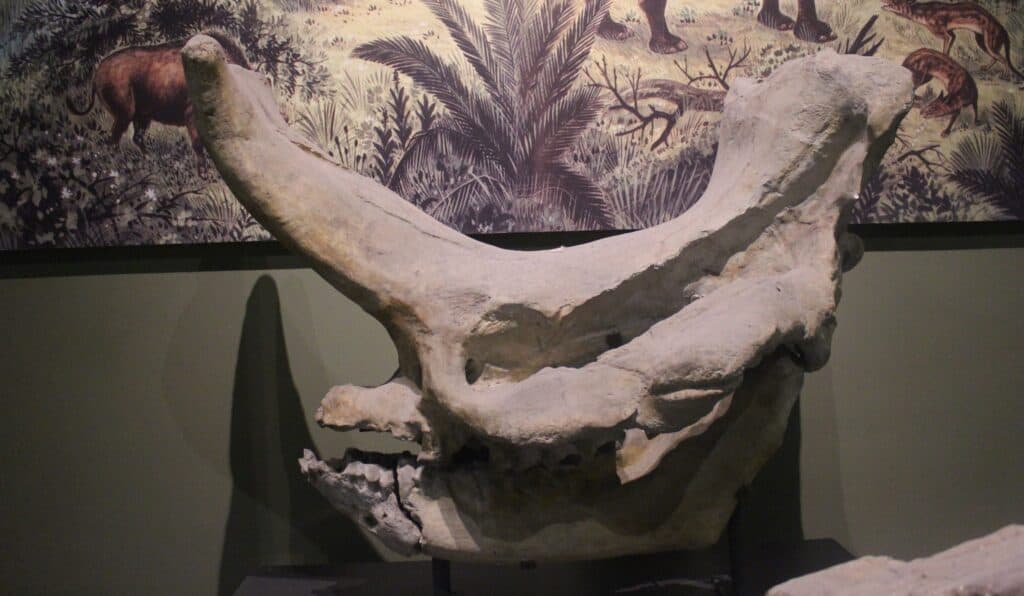Fossils are very important in helping humans learn about the past. With earth having an estimated age of around 4.543 billion years, an unimaginable amount of life once called the planet its home. The five extinction events that occurred on earth wiped out many species, but luckily fossils are here to help piece together the extensive history of life. This article will take a look at the now-extinct Embolotherium, also called the “Battering Ram Beast”. Some may say this animal looks like a failed rhino because of their uniquely shaped head, but there are many other interesting things to learn about them.
What is the Embolotherium?

The Embolotherium lived during the late Eocene Epoch in East Asia.
©Tim Bertelink / CC BY-SA 4.0, Wikimedia Commons – License
The Embolotherium is an extinct genus of animal, whose name translates from Greek into the “Battering Ram Beast”, or “Wedge Beast”. This animal lived during the late Eocene Epoch in East Asia. Its name is in reference to the large protrusion from its skull that makes it look like a failed rhino. Embolotherium is in the Brontotheriidae family and in the order Perissodactyla. They are distant relatives to animals like horses, tapirs, and rhinos.
Several species of this ancient genus are suggested, but only two are considered valid, Emblotherium andrewsi, and Embolotherium grangeri. Studies and debates are still undergoing about how many species there are in total. The Embolotherium was a very large ancient mammal, known only by incomplete fossil remains.
Discovery and Fossils of the Embolotherium

The Embolotherium was a very large ancient mammal, known only by incomplete fossil remains.
©Jonathan Chen / CC BY-SA 4.0 – License
While there are no complete fossils of the Embolotherium, plenty of evidence exists that allows for an in-depth study of the ancient animal. 1928 in the Ulan Gochu formation in Inner Mongolia is where the first fossils of Embolotherium were discovered. Sponsored by the American Museum of Natural History, American explorer Roy Chapman Andrews and paleontologist Walter W. Granger led an expedition into China to uncover fossils within the rich geological layer.
The first remains found of this species were several specimens and fragmented skulls. Other jaws and skull fossils of the Emolotherium have been uncovered in the Baron Sog Formation and Shara Murun Formation. Fossils of this animal are only known in East Asia, including findings within the Gobi desert.
Belonging to the Brontotheriidae family, other animals like the Megacerops from North America have helped depict how the Embolotherium looked. When originally described over a dozen species of Embolotherium were listed, but further studies have cut down the number of species to only two.
Size and Appearance
No complete fossil of Embolotherium has been found but using other fossils found of other Brontotheriidae like the Megacerops, scientists are able to estimate their size. Embolotherium is estimated to have had a height of 8 feet tall, and a length of up to 16 feet. One of the largest of its kind, they are estimated to have weighed around 4,400 lbs.
This species is sometimes called the “Battering Ram Beast” because they have a large bony growth that protrudes from its face, which is around 2.2 feet in length. Depictions of this animal show them looking very similar to modern rhinos, but they have large bony growth instead of a horn. It is theorized that the large ram may have been used as a resonator for amplifying their sound. All known specimens of them have rams, and it is debated whether they were sexually dimorphic.
Diet and Habitat of Embolotherium
The Embolotherium lived in Mongolia, and other regions in East Asia, with most fossils being found in the Gobi Desert. This animal lived during the Eocene Epoch, around 41 to 34 million yeast ago. During this time period, the dry desert that we know of looked much different. Plants were abundant in the area, and it was more of a wetland habitat.
The teeth of Embolotherium suggested they were herbivores. Softer vegetation is what they ate. They had shearing teeth instead of grinding ones. Plant life that did not require much chewing is what they fed on. Wetland habitats with lots of soft plants are where this animal likely lived, roaming around looking for food.
Extinction of Embolotherium
Despite its massive size and success in the Eocene age, the Embolotherium went extinct at the end of the Eocene epoch. The main reason was climate change, and by the end of the Eocene, the region of Asia this animal lived in became drier. The soft plants relied on by this large beast were replaced with drier vegetation that was harder for them to eat. Other animals adapted, and outcompeted the Embolotherium into extinction.
Up Next:
Take a look at other amazing ancient animals that roamed the earth millions of years ago:
- 11 Ancient Mammals that Lived Alongside Dinosaurs
- Gigantic Ancient Badger Now Believed to Feast on Dinosaurs
- This Ancient Whale Sized Fish Was a “Suction Eater” Without Teeth
- This Ancient Mongolian Predators Was As Tall As A Horse And Weighed a Ton
The photo featured at the top of this post is © Tim Bertelink / CC BY-SA 4.0, Wikimedia Commons – License / Original
Sources
- Fossil Works , Available here: http://www.fossilworks.org/cgi-bin/bridge.pl?a=taxonInfo&taxon_no=43037
- Embolotherium , Available here: https://en.wikipedia.org/wiki/Embolotherium
- Prehistoric Wildlife , Available here: http://www.prehistoric-wildlife.com/species/e/embolotherium.html
Thank you for reading! Have some feedback for us? Contact the AZ Animals editorial team.






